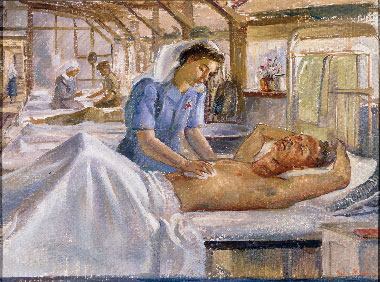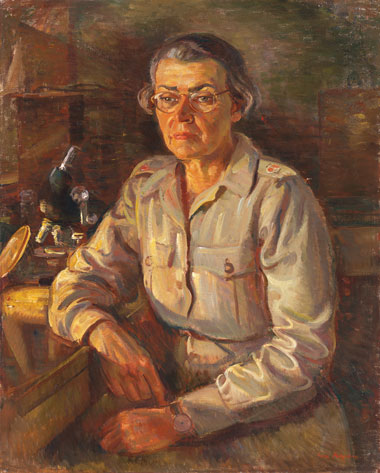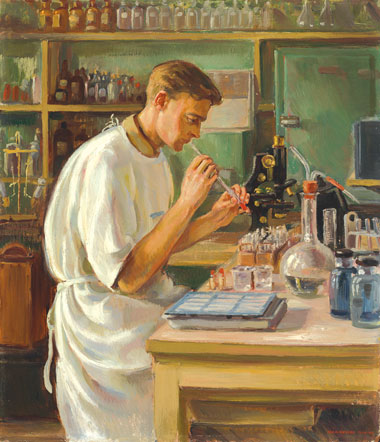Throughout history there has been a long association between war and infectious disease. Until relatively recently, the number of casualties from disease outnumbered those who died in action, with battles often decided by the side that could put the most healthy soldiers into the front line.1 For much of the history of war, research and technological innovation has been dedicated to developing greater destructive capacity, rather than protecting troops from disease epidemics such as malaria.
We describe the progress in malaria prevention and treatment made by Australian medical servicemen and women, and its historical documentation by Australia’s first female official war artist, Nora Heysen (see Box, and illustrations). Heysen’s works are now part of the Australian War Memorial collection and are the subject of an exhibition titled “The War on Malaria”, which will be displayed until mid 2011.
The debilitating impact of malaria on fighting capacity was encountered by Australian forces in the First World War. While its impact on the Gallipoli campaign was relatively minor, the Palestine campaign included fighting within the Jordan valley, an area of high malaria transmission.2-4 By the end of the campaign, almost half the 40 000-strong Desert Mounted Corps had been evacuated because of illness, with 6347 men testing positive for malaria.1
At that time, mobile diagnosis units and techniques such as drainage of low-lying water were used to reduce malarial infection.5 Despite these efforts, it was fortunate that victory came swiftly to the allied forces in Palestine, as twin epidemics of malaria and influenza broke out within weeks of the start of the final offensive in September 1918.1
During the Second World War, from June 1941, Australian troops were sent to Port Moresby in Papua New Guinea (PNG) in response to the threat from Japanese forces advancing in areas of the Pacific. Because Port Moresby is in a relatively dry coastal area, the potential impact of malaria on the war in the Pacific was initially underestimated.4
In the first 6 months of 1942, 1184 cases of malaria were recorded among the 6500 Australians serving in Port Moresby.6 Initially, most of these cases were caused by Plasmodium vivax, but by June 1942, most cases arose from infection with the more serious Plasmodium falciparum. An irregular supply of the suppressive drug quinine contributed to high infection rates among Australian troops. By November 1942, an epidemic of malaria had broken out, with rates of incidence increasing from 33 men per 1000 per week to 82 men per 1000 per week by December that year.6
The Australian response to the malaria threat in the Pacific was led by Colonel (later Brigadier) Neil Hamilton Fairley. He drew on his experiences in Egypt during the First World War where he had seen firsthand the impact of malaria through his work in the 14th Australian General Hospital.7 Fairley’s experience was vital as interest in protective measures against malarial infection grew in the light of its impact on the Pacific campaign.
In 1942, Fairley, as Director of Medicine for the Australian Army, along with a University of Sydney research chemist, Dr Adrien Albert, travelled to England and the United States to highlight the risk posed by malaria in the Pacific.8 This trip led to discussion about the urgency to reduce malarial infection in the Pacific region. In June 1943, the Land Headquarters Medical Research Unit was established at the 5 Australian Camp Hospital in Cairns, Queensland.6,9
The Unit’s first research experiments, under the directorship of entomologist Major Mabel Josephine Mackerras, involved collecting mosquito pupae of the Anopheles punctulatus group in PNG and flying them to Cairns, where they grew to maturity in specially built laboratories.8 Servicemen carrying P. falciparum or P. vivax gametocytes were exposed to the adult mosquitoes, which were then used to infect malaria-free volunteers from across Australia.8 Testing of a new antimalarial drug, atebrin (developed by German chemists not long before the war), was then conducted under diverse physical conditions to simulate war conditions, including extremes of temperature and intense physical activity.8,9 Regular reading of blood smears made it clear that atebrin prevented malaria under the most extreme conditions.4
The outcomes of this research were first reported, by Fairley, at a conference on the prevention of disease in warfare in June 1944.9 Among the key findings were that the administration of 0.1 g (equivalent to one atebrin tablet daily) cured P. falciparum malaria and suppressed the onset of P. vivax malaria.6 Further, once an adequate level was achieved and maintained in the bloodstream, participants could be subjected to demanding physical activity and extreme temperatures without the recurrence of any malaria symptoms.8,9 However, at that same conference, Major James C English of the 1 Australian Corps also reported that field malariologists were concerned about a total reliance on atebrin for treatment. Tests had shown recurrence of P. vivax malaria if treatment was ceased — a likely possibility on the battlefield because of irregular supply.6
The influence of this new research was evident in the adoption of widespread discipline in malaria prevention in subsequent military operations in the Pacific.9 However, the concerns of malariologists were confirmed with a new outbreak among Australian servicemen in Aitape and Wewak. Further complications emerged in instances where a single tablet of atebrin was not adequate, but two tablets resulted in the complication of skin eruptions.6 The investigation of the Aitape–Wewak outbreak was one of the first studies of malarial resistance to drug treatment in humans,8 and led to research into other treatment approaches.
Provenance: Not commissioned; externally peer reviewed.
- Cherie L Prosser1
- Ian A Clark2
- 1 Art Section, Australian War Memorial, Canberra, ACT.
- 2 Research School of Biology, Australian National University, Canberra, ACT.
We thank Professor Karl Rieckmann for providing details from his studies of the history of malaria control.
None identified.
- 1. Shanks GD. Simultaneous epidemics of influenza and malaria in the Australian Army in Palestine in 1918. Med J Aust 2009; 191: 654-675.
- 2. Downes RM. The campaign in Sinai and Palestine. In: Official history of the Australian Army Medical Services, Vol. 1: Gallipoli, Palestine and New Guinea. 2nd ed. Sydney: Halstead Press, 1938.
- 3. Gullet HS. The Australian Imperial Force in Sinai and Palestine, 1914-1918. In: The official history of Australia in the War of 1914–1918. Vol. VII: Sinai and Palestine. Sydney: Angus & Robertson, 1923.
- 4. Sweeney T. Malaria frontline: Australian Army research during World War II. Melbourne: Melbourne University Press, 2003.
- 5. Angus W. Report on malaria in the Egyptian Expeditionary Force during 1918. Cairo: Egyptian Expeditionary Force, January 1919: 1-51. Australian War Memorial, Canberra.
- 6. Fenner F. Malaria control in Papua New Guinea in the Second World War: from disaster to successful prophylaxis and the dawn of DDT. Parassitologia 1998; 40: 55-63.
- 7. Fairley NH. The causes of death from malaria in Palestine: a study in cellular pathology. Trans R Soc Trop Med Hyg 1920; 13: 121-125.
- 8. Fenner F, Sweeney AW. Malaria in New Guinea during the Second World War: the Land Headquarters Medical Research Unit. Parassitologia 1998; 40: 65-68.
- 9. Walker AS. Clinical problems of war. In: Official history of Australia in the War of 1939–1945, Series 5, Vol. 1. Sydney: Halstead Press, 1952.
- 10. Rieckmann KH. The chequered history of malaria control: are new and better tools the ultimate answer? Ann Trop Med Parasitol 2006; 100: 647-662.








Abstract
With the expansion of the Second World War into the Pacific in 1941, and due to the deleterious impact of malarial infection on fighting capacity, the Australian Army devoted significant resources to new research into the prevention and treatment of malaria between 1943 and 1945 by forming the Land Headquarters Medical Research Unit in Cairns, Queensland.
The documentation of this research became a significant subject for leading Australian artist Nora Heysen, when she was commissioned as the first female war artist by the Australian War Memorial in 1943.